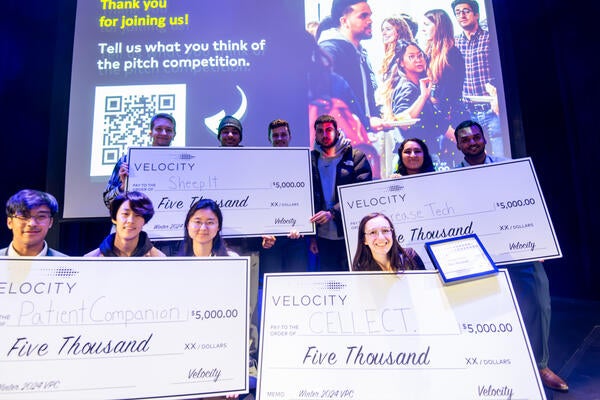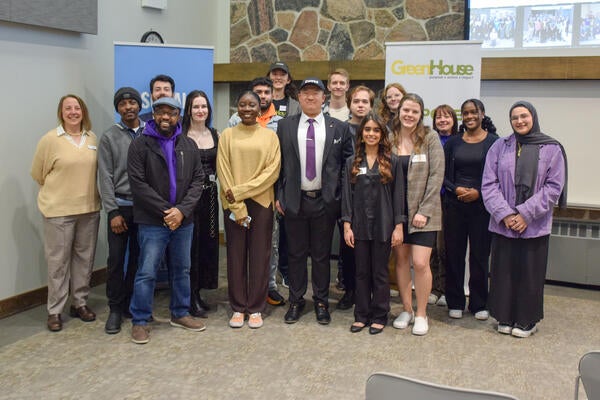
Combatting misinformation
Comparing stories to broaden perspectives

Comparing stories to broaden perspectives
By Etta Di Leo University RelationsSukh Singh (BASc ‘12) and Harleen Kaur were frustrated with how they saw news being presented and how it was fueling the spread of misinformation. In 2017, the brother-sister team launched Ground News as a way to provide the public with a full picture of the news stories they’re consuming.
Dubbed as the world’s first news comparison platform, Ground News helps users see how news stories are covered around the world and across the political spectrum. It then goes deeper to reveal where and when the story originated and how the narrative changes over time and across geography.
“Right after the 2016 U.S. presidential election, information came out that bot farms had been spreading misinformation to influence the election,” says Kaur. “At the same time, President Trump started using the term “fake news” to discredit the mainstream media by targeting CNN and the New York Times among others. We realized technology was being used to weaponize the news. We knew there had to be a way of to give people a better view of the news so they had a chance to distinguish what was real and what was being made up and if there was a political agenda behind the story.”
The siblings are not journalists by trade. Kaur, the company’s CEO, is a former NASA engineer and was the first female VP at Rolls-Royce. Singh, who is the company’s CTO, is a software engineer. For Singh, the pull towards entrepreneurship began while he pursued his University of Waterloo undergraduate degree.
“The co-op program at Waterloo gave me the chance to explore a lot of different options for a career in engineering. My most valuable co-op term was when I got to work on an entrepreneurial venture and see the ins and outs of the startup world and what's involved day-to-day,” says Singh. “The less appreciated part of the co-op program is that, as a fresh grad, you don’t just have the work experience but also the opportunity to understand what type of work makes you happy. That certainly was the case for me. I knew by the end of my degree at Waterloo that I wanted to be an entrepreneur.”
The two first began to work together in 2015 on their first collaboration called uCIC (you see, I see). With uCIC, users uploaded real time photos and videos, allowing other users anywhere in the world to see what the posters were seeing. While the platform was successful, they saw a need for technology that could focus on news.
“We want people to have the tools they need to analyze the news and draw their own conclusions,” says Kaur. “We all exist within our own content bubbles, and we tend to consume news that aligns with our world views. We can only get the full picture of the news when we look at all perspectives.”
Singh explains that consumers are inadvertently helping to spread misinformation by relying on social media sites, such as Twitter and Facebook, as their primary news source.
“Twitter and Facebook didn’t set out to become a primary source for news. There is no way to verify if a story is true. A post can be shared 20,000 times in an unbelievably short period of time. Unfortunately, people take social validation as a sign of truth,” says Singh. “We want to reverse that movement and provide people with a way to understand how the story changes depending on who is telling it.”
Singh and Kaur quickly got to work on a solution for helping consumers wade through the myriad of news sources.
“As technologists, we knew that many (but not all) of the disinformation problems could be solved with an automated and scalable solution,” says Singh. “Best of all, the source material was readily available. Lots of different news outlets with varying opinions, biases and agendas cover similar news stories so it is possible for us to put them all together as a neat package for a Ground News user.”
The app was well received with more than 10,000 downloads in the first few weeks. The numbers have grown steadily, and the app now has hundreds of thousands of current users.
The current pandemic has once again magnified the dangers of misinformation and political bias in the news. Scientists are struggling to share potentially lifesaving information about a virus that’s never been seen before. At the same time, the public that has become accustomed to instant information has shown little patience for a scientific process that would normally take years to fully understand the threats, impacts, and treatments needed. Social media has been flooded with misinformation that, at best, has caused frustration and, in some cases, has contributed to the spread of COVID-19.
“We’re seeing the need for a better informed, critically thinking public more than ever before,” says Kaur. “We believe that with thoughtful application of technology we can help mitigate misinformation, sensationalism, bias, special interests, echo chambers, corruption, and lack of financial sustainability for news outlets.”
Both co-founders are eager to see how the world evolves after the pandemic. Kaur is looking forward to participating in the Waterloo Innovation Summit on August 19, 2020.
“Innovation will see us through to the other side of this crisis,” says Kaur. “If you can weather the COVID storm, there will be opportunities that will follow. Static circumstances help maintain the status quo, but turbulent times mean startups like ours can make strides that were not possible before. The news industry has gotten a new spotlight in this pandemic. I’m sure other innovators will find new, unaddressed opportunities to tackle in the new normal.”

Read more
With grants at stake, students pitch inventive startup ideas to bring their entrepreneurial visions into reality

Read more
GreenHouse awards more than $14,000 to five student founded ventures making an impact towards several UN Sustainable Development Goals

Read more
Transformative AI innovations, data and ethics are the focus across digital health academia, clinical practice and industry
The University of Waterloo acknowledges that much of our work takes place on the traditional territory of the Neutral, Anishinaabeg and Haudenosaunee peoples. Our main campus is situated on the Haldimand Tract, the land granted to the Six Nations that includes six miles on each side of the Grand River. Our active work toward reconciliation takes place across our campuses through research, learning, teaching, and community building, and is co-ordinated within the Office of Indigenous Relations.